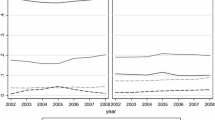Abstract
This paper examines the size, scope, and potential implications of trade in high-tech services in the U.S. The results suggest that many service activities are tradable, tradable service activities tend to employ more educated workers and pay higher wages, and high-tech services account for a large share of service activities that are tradable. Service exporters are more prevalent in high-tech industries with larger establishments and higher wages. Within industries, service exporters tend to be larger, pay higher wages, and are more productive. Tradable service activities seem consistent with U.S. comparative advantage and, as a result, less likely to be vulnerable to offshoring. Consistent with this, recent employment growth in tradable service industries is not significantly different than employment growth in non-tradable service industries.




Similar content being viewed by others
Notes
See Jensen and Kletzer (2006).
See Blinder (2006).
The specific definition of “high-tech” used in this paper depends to a degree on the particular dataset being used for the empirical analysis. It typically includes industries contained in NAICS sector 50 (Information; Financial services; Real Estate; Professional, Scientific, and Technical services; Management; and Administrative Support) or occupations in Standard Occupational Categories Business and Financial Operations; Computer and Mathematical, Architecture and Engineering, and Life Physical and Social Sciences. In some cases, subsets of these categories are reported.
The location quotient is the share of an industry’s employment in a region relative to the share of total employment in a region. These calculations are made using the 2000 Decennial Public Use Micro Sample.
If a service is non-tradable and demand for the service is concentrated (the industries that use the non-traded service are geographically concentrated), the service industry will be geographically concentrated and the analysis would incorrectly infer that the service is tradable. Jensen and Kletzer adjust their measure of geographic concentration to correct for this possibility and construct region specific measures of demand for each industry using the input-output use tables produced by the Bureau of Economic Analysis.
This figure is taken from Jensen and Kletzer (2006).
The calculations use the 2000 Decennial Public Use Micro Sample.
These calculations use the 2000 Decennial Public Use Micro Sample.
The NAICS 50s are: Information; Financial services; Real Estate; Professional, Scientific, and Technical services; Management; and Administrative Support services. The employment growth rates are calculated for the period 1998–2004 using County Business Pattern data.
The 1998–2004 period includes the dot com and telecommunications industry bust making it more difficult to draw definitive conclusions regarding employment growth. Jensen and Kletzer also report analysis of job displacement rates for tradable activities.
Bernard and Jensen (1997) examine the impact of reallocation to exporters on the relative demand for and wages paid to skilled workers in the U.S. manufacturing sector.
These calculations use establishment level data from the 2002 Census of Service Industries.
Bernard and Jensen (1997) examine how shifts in economic activity towards exporters contributed to wage inequality in the 1970s and 1980s in the U.S.
References
Bernard, A.B., Eaton, J., Jensen, J.B., and Kortum, S.S., “Plants and productivity in international trade,” American Economic Review, vol. 93(4), pp. 1268–1290, 2003.
Bernard, A.B. and Jensen, J.B., “Exporters, jobs and wages in U.S. manufacturing,” 1976–87. Brookings Papers on Economic Activity: Microeconomics, 1995.
Bernard, A.B. and Jensen, J.B., “Exporters, skill upgrading, and the wage gap,” Journal of International Economics, vol. 42, pp. 3–31, 1997.
Bernard, A.B. and Jensen, J.B., “Exceptional exporter performance: cause, effect, or both?” Journal of International Economics, vol. 47(1), pp. 1–26, 1999.
Bernard, A.B. and Jensen, J.B., “Firm structure, multinationals and manufacturing plant deaths,” Review of Economics and Statistics, vol. 89(2), pp. 193–204, 2007.
Bernard, A.B., Jensen, J.B., and Schott, P.K., “Survival of the best fit: competition from low wage countries and the (Uneven) growth of U.S. manufacturing plants,” Journal of International Economics, vol. 68(1), pp. 219–237, 2006a.
Bernard, A.B., Jensen, J.B., and Schott, P.K., “Trade costs, firms, and productivity,” Journal of Monetary Economics, vol. 53(5), pp. 917–937, 2006b
Bernard, A.B., Redding, S.J., and Schott, P.K., “Comparative advantage and heterogeneous firms,” Review of Economic Studies, vol. 74(1), pp. 31–66, 2007.
Blinder, A.S., “Offshoring: the next industrial revolution?” Foreign Affairs, vol. 85(2), 2006, March/April.
Jensen, J.B. and Kletzer, L., “Tradable services: understanding the scope and impact of services offshoring,” in Brainard, L. and Collins, S.M. (eds.), Offshoring White-Collar Work – Issues and Implications, Brookings Trade Forum 2005, pp. 75–134, 2006.
Jensen, J.B., “Service Exporters: Comparative Advantage Across and Within Service Industries,” 2006, manuscript.
McKinsey Global Institute, The Emerging Global Labor Market, 2005.
Melitz, M.J., “The impact of trade on intra-industry reallocations and aggregate industry productivity,” Econometrica, vol. 71, pp. 1695–1725, 2003, November.
Author information
Authors and Affiliations
Corresponding author
Additional information
The author wishes to thank the Sloan Foundation, the MacArthur Foundation, and the National Science Foundation (SES-0552029) for research support and Evan Gill for research assistance. Some of the research in this paper was conducted while the author was a Special Sworn Status researcher of the U.S. Census Bureau at the Center for Economic Studies. Research results and conclusions expressed are those of the author and do not necessarily indicate concurrence by the Bureau of the Census or the NBER. The paper has not undergone the review the Census Bureau gives its official publications. It has been screened to insure that no confidential data are revealed.
Rights and permissions
About this article
Cite this article
Jensen, J.B. Trade in High-Tech Services. J Ind Compet Trade 8, 181–197 (2008). https://doi.org/10.1007/s10842-008-0035-0
Published:
Issue Date:
DOI: https://doi.org/10.1007/s10842-008-0035-0




